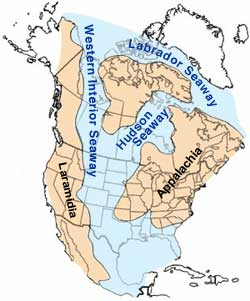american oceans.png

The Western Interior Sea used to rest on top of and run throughout North America. Photo Credit: United States Geological Survey
A hundred million years ago, Kansas was inhabited by some creatures with big, sharp teeth: sharks up to 30 feet long, a fish that’s been described as a tarpon with fangs, and a 45-foot dinosaur that was one of the deadliest predators on the planet.
That’s because Kansas was at the bottom of a sea that stretched from the Arctic to the Gulf of Mexico. Known as the Western Interior Sea, it was up to a thousand miles wide. Its warm, shallow waters supported an abundance of life, including giant clams, giant fish, and giant dinosaurs.
The sea took shape when shifts in Earth’s crust caused parts of North America to subside. The planet was so warm then that sea level was a thousand feet higher than it is today. Ocean water spilled into North America from both north and south. By a hundred million years ago, these fingers of water had linked up. The newly formed sea stretched from Alaska, through parts of the mountain west and the Great Plains, and down through Texas. That divided the continent into western and eastern halves, known as Laramidia and Appalachia.
The contours of the Western Interior Sea varied over the millennia. And sediments created vast beds of limestone. About 65 million years ago, a gap appeared in the sea, breaking it into northern and southern branches. They quickly retreated, reuniting the two halves of North America -- but leaving behind a fossil record that tells us about life in this ancient American sea.

